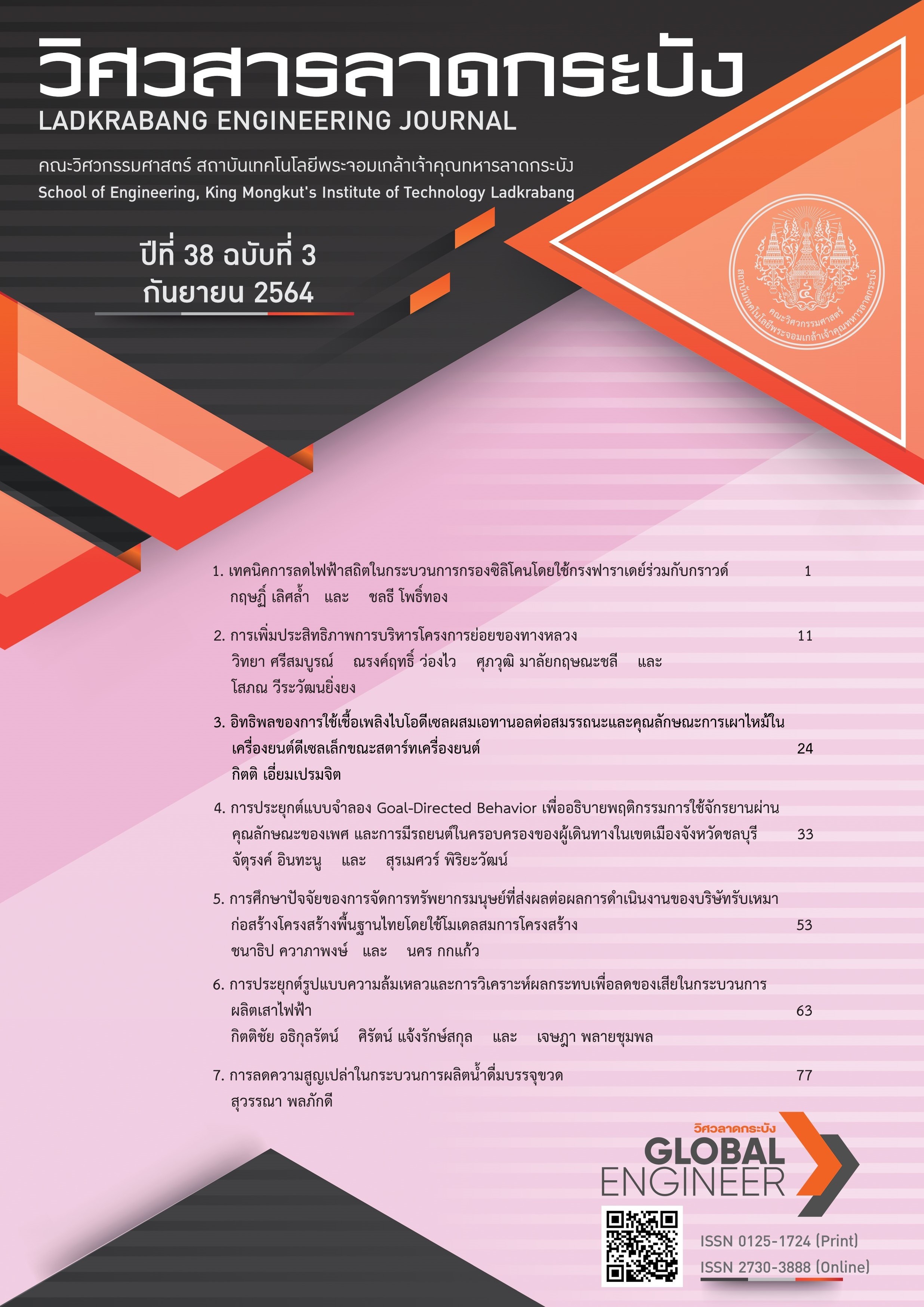การลดความสูญเปล่าในกระบวนการผลิตน้ำดื่มบรรจุขวด
คำสำคัญ:
กระบวนการผลิตน้ำดื่มบรรจุขวด, ความสูญเปล่า, แผนผังสายธารคุณค่า, แนวคิดแบบลีนบทคัดย่อ
งานวิจัยนี้มีวัตถุประสงค์เพื่อค้นหาความสูญเปล่าแปดประการที่เกิดขึ้นตามแนวคิดของลีน และเสนอแนวทางการลดความสูญเปล่าให้กับกระบวนการผลิตน้ำดื่มบรรจุขวดโดยประยุกต์ใช้แผนผังสายธารคุณค่า ตัวชี้วัดในงานวิจัยคือ เวลานำ โดยกระบวนการผลิตน้ำดื่มบรรจุขวดประกอบด้วย 4 ขั้นตอนหลักคือ ขั้นตอนการเตรียมน้ำก่อนเข้ากระบวนการผลิต ขั้นตอนเติมน้ำลงขวด ขั้นตอนการบรรจุน้ำลงพาเลท และขั้นตอนการจัดส่งสินค้า จากการวิเคราะห์ความสูญเปล่าจากผังสายธารคุณค่าสถานะปัจจุบัน พบว่ามีความสูญเปล่า 2 ประการคือ ความสูญเปล่าจากกระบวนการทำงานที่ไม่เหมาะสม และความสูญเปล่าจากปริมาณสินค้าคงคลังที่มีมากเกินไป แนวทางในการลดความสูญเปล่าดังกล่าวคือ การออกแบบสเกลนับจำนวนพาเลทชีท และออกแบบฟังก์ชันการกรอกข้อมูลในไฟล์เอกซ์เซลให้มีความถูกต้อง เพื่อลดความสูญเปล่าจากกระบวนการทำงานที่ไม่เหมาะสม และประยุกต์ใช้ตัวแบบปริมาณการสั่งผลิตที่ประหยัดที่สุดของน้ำดื่มบรรจุขวดแต่ละขนาด เพื่อลดความสูญเปล่าจากการมีปริมาณสินค้าคงคลังมากเกินพอดี ผลจากการลดความสูญเปล่าพบว่า เวลานำของกระบวนการผลิตน้ำดื่มบรรจุขวดลดลงจาก 230,598 วินาที เหลือ 228,588 วินาที (ลดลง 33.5 นาที) หรือคิดเป็นร้อยละ 0.88
References
NALISA, “bottled water market” marketeeronline.co. https://marketeeronline.co/archives/217681 (accessed Jun. 28, 2021)
M. Helmold, “Basics in Lean Management,” in Lean Management and Kaizen: Fundamentals from Cases and Examples in Operations and Supply Chain Management, Cham, Switzerland: Springer, 2020, pp. 1–14.
N. Balakrishnan, “Toyota Production System,” in Dependability in Medicine and Neurology: Using Engineering and Management Principles for Better Patient Care, Cham, Switzerland: Springer International Publishing, 2015, pp. 239–260.
R. S. Barot, K. Raval, H. Beravala and A. Patel, “Implementation of lean practices in water heater manufacturing industry,” Materials Today: Proceedings, vol. 38, pp. 2227–2234, 2021, doi: 10.1016/j.matpr.
06.304.
A. K. Dhingra, S. Kumar, and B. Singh, “Cost reduction and quality improvement through Lean-Kaizen concept using value stream map in Indian manufacturing firms,” International Journal of System Assurance Engineering and Management, vol. 10, no. 4, pp. 792–800, 2019, doi: 10.1007/s13198-019-00810-z.
P. Ribeiro, J. C. Sa, L. P. Ferreira, F. J. G. Silva, M. T. Pereira and G. Santos, “The Impact of the Application of Lean Tools for Improvement of Process in a Plastic Company: a case study,” Procedia Manufacturing, vol. 38, pp. 765–775, 2019, doi: 10.1016/j.promfg.2020.01.
Kanitsorn Poonikom, “Efficiency Improvement in Manufacturing Process by Improvement Technique Case Study: Drinking Water Bai-Pai-Keaw”, in Industrial Engineering Networking Conference 2017, Chiang Mai, Thailand, 2017, pp.150–155.
W. Jantana and W. Sapsanguanboon, “Productivity Improvement in Ceramic Production Process: A Case Study of Factory in Samut Prakan Province,” Songklanakarin Journal of Management Sciences, vol. 37, no. 2, pp. 58–83, 2020.
W. Cheewaworanontree, P. Rontlaong, and N. Boonrak, “Motion and Time Study: A Case Study on A Short-Time Hydrostatic Failure Pressure Testing Process of Rigid PVC Plain-End Pipes,” The Journal of Industrial Technology: Suan Sunandha Rajabhat University, vol. 6, no. 1, pp. 26–38, 2018.
P.Krailomsom, T. Miengarrom, W. Leelawan “Increasing the Efficiency of the Bottled Water Packaging Process Movement by Using the Kaizen Concept: Case Study Drinking Water Factory,” Industrial Technology Research Journal Phranakhon Rajabhat University, vol.3, no. 2, pp.1–8, 2020.
W. Impho and K. Poonikom, “Increasing efficiency in the production process of drinking water using lean technical: Case study of drinking water Thanthip production,” SNRU Journal of Science and Technology, vol. 9, no. 3, pp. 653–660, 2017
P. Roh, A. Kunz and K. Wegener, “Information stream mapping: Mapping, analysing and improving the efficiency of information streams in manufacturing value streams,” CIRP Journal of Manufacturing Science and Technology, vol. 25, pp. 1–13, 2019, doi: 10.1016/j.cirpj.2019.04.004.
N. Thinakaran, J. Jayaprakas and C. Elanchezhian, “Survey on Inventory Model of EOQ & EPQ with Partial Backorder Problems,” Materials Today: Proceedings, vol. 16, pp. 629–635, 2019, doi: 10.1016/ j.matpr.2019.05.138.
A. A. Taleizadeh, V. R. Soleymanfar and K. Govindan, “Sustainable economic production quantity models for inventory systems with shortage,” Journal of Cleaner Production, vol. 174, pp. 1011–1020, 2018, doi: 10.1016/j.jclepro.2017.10.222.
S. Kumar, A. K. Dhingra and B. Singh, “Process improvement through Lean-Kaizen using value stream map: a case study in India,” The International Journal of Advanced Manufacturing Technology, vol. 96, no. 5–8, pp. 2687–2698, 2018, doi: 10.1007/s00170-018-1684-8.
Downloads
เผยแพร่แล้ว
How to Cite
ฉบับ
บท
License
บทความที่ได้รับการตีพิมพ์เป็นลิขสิทธิ์ของคณะวิศวกรรมศาสตร์ สถาบันเทคโนโลยีพระจอมเกล้าเจ้าคุณทหารลาดกระบัง
ข้อความที่ปรากฏในบทความแต่ละเรื่องในวารสารวิชาการเล่มนี้เป็นความคิดเห็นส่วนตัวของผู้เขียนแต่ละท่านไม่เกี่ยวข้องกับสถาบันเทคโนโลยีพระจอมเกล้าเจ้าคุณทหารลาดกระบัง และคณาจารย์ท่านอื่นๆในสถาบันฯ แต่อย่างใด ความรับผิดชอบองค์ประกอบทั้งหมดของบทความแต่ละเรื่องเป็นของผู้เขียนแต่ละท่าน หากมีความผิดพลาดใดๆ ผู้เขียนแต่ละท่านจะรับผิดชอบบทความของตนเองแต่ผู้เดียว






